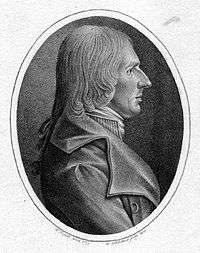Johann Kaspar Hechtel
| Johann Kaspar Hechtel | |
|---|---|
|
Stipple engraving portrait by Leonhard Schlemmer (1800) after Leonhard Heinrich Hessell (1799) | |
| Born |
Johann Kaspar Hechtel 1 May 1771 Nuremberg, Bavaria, Germany |
| Died |
20 December 1799 (aged 28) Nuremberg, Bavaria, Germany |
| Nationality | Germany |
| Occupation | Businessman, writer, board game designer |
Johann Kaspar Hechtel (1 May 1771 – 20 December 1799) was a German businessman, owner of a brass factory in Nuremberg, non-fiction writer and designer of parlour games including the prototype for the Petit Lenormand cartomancy deck. According to published biographies, Hechtel also contributed anonymously to some treatises on physics.[1][2][3][4]
Early life
Hechtel was born on 1 May 1771 in Nuremberg.[1][2]
Death
Hechtel died on 20 December 1799 in Nuremberg during a smallpox epidemic and was survived by a wife.[1][2][5]
Works
- Sammlung freundschaftlicher Denkmale und kleine Lehren der Weisheit und Tugend. Zum Gebrauch in Stammbücher und zur Geistes- und Sittenveredlung junger Leute bestimmt. (Bieling, 1798)
- Second edition: Denkmale der Freundschaft und kleine Lehren der Weisheit und Tugend, zum Gebrauch in Stammbücher und Geistes- und Sittenveredlung junger Leute (Bieling, 1803)
- Third edition: Denkmale der Freundschaft für Stammbücher und moralische Lehren zur Sittenveredlung junger Personen (Bieling, 1809)
- Fourth edition: Denkmale der Freundschaft für Stammbücher und moralische Lehren zur Sittenveredlung junger Personen (Bieling, 1819)
- Beiträge zur geselligen Freude oder Auswahl neuer Karten- Pfänder- und Unterhaltungsspiele zum Nutzen und Vergnügen, mit illumirten Kupfern (Bieling, 1798)
- Pandora, ein neues Würfel- und Gesellschaftspiel mit 24 Fragen und 144 scherzhaften Antworten (Bieling, 1798)
- Das Spiel der Hoffnung, eine angenehme Gesellschaftsunterhaltung mit 36 neuen illumirten Figurenkarten, franz. und deutsch (Le Jeu de l'Esperance, accompagné d'un nouveau jeu de cartes à figures) (Bieling, c1799)
Lenormand cards
In the mid 19th century after the death of the famous French fortune-teller Marie Anne Lenormand, Lenormand's name was used on several cartomancy decks including a deck of 36 illustrated cards known as the Petit Lenormand or simply Lenormand cards still used extensively today. The 36 card Lenormand deck is modelled on a deck of cards published c1799 as part of Das Spiel der Hoffnung (The Game of Hope), a game of chance designed by Hechtel which was still being advertised in 1820. So-called Lenormand decks have the same card numbering, primary symbols and playing card associations as the cards in Hechtel's Das Spiel der Hoffnung game. Some examples of the game are included in an extensive collection of playing cards bequeathed to the British Museum by Lady Charlotte Schreiber. Das Spiel der Hoffnung is listed among Hechtel's works in an advertisement by publisher Gustav Philipp Jakob Bieling of Nuremberg dated 1799.[4][6][7][8][9]
References
- 1 2 3 Will, Georg Andreas; Nopitsch, Christian Conrad (1805). Nürnbergisches Gelehrten-Lexicon: Sechster Theil von H-M. Altdorf bei Nürnberg. External link in
|title=(help) - 1 2 3 Meusel, Johann Georg (1805). Lexikon der vom Jahr 1750 bis 1800 verstorbenen teutschen Schriftsteller, Band 5. Leipzig: Gerhard Fleischer. External link in
|title=(help) - ↑ Kayser, Christian Gottlob (1835). Vollständiges Bücher-Lexikon 1750-1832: Dritter Theil H-L. Leipzig: Ludwig Schumann. External link in
|title=(help) - 1 2 Humoristische Blätter für Kopf und Herz. Nuremberg: Gustav Philipp Jakob Bieling. 1799. External link in
|title=(help) - ↑ Veillodter, Valentin Karl (1800). Denkmal der Freundschaft bei dem Grabe eines würdigen Mannes, Herrn Johann Kaspar Hechtels, im Namen seiner hinterlassenen Gattin und seiner vertrautesten Freunde berichtet. Nuremberg.
- ↑ Hoffmann, Detlef; Kroppenstedt, Erika (1972). Wahrsagekarten: Ein Beitrag zur Geschichte des Okkultismus. Bielefeld: Deutsches Spielkarten Museum. pp. 17, 21.
- ↑ O'Donoghue, Freeman Marius (1901). Catalogue of the Collection of Playing Cards Bequeathed to the Trustees of the British Museum by the late Lady Charlotte Schreiber. London: British Museum. External link in
|title=(help) - ↑ Decker, Ronald; Depaulis, Thierry; Dummett, Michael (1996). A Wicked Pack of Cards: The Origins of the Occult Tarot. London: Gerald Duckworth and Company. pp. 141, 282. ISBN 9780715627136.
- ↑ Neue Jugendzeitung. Leipzig: Industrie Comptoir. 1820. External link in
|title=(help)
External links
- British Museum: Das Spiel der Hofnung
- Tarot History Forum discussion thread: German Lenormand 1846 / Spiel der Hoffnung 1799

